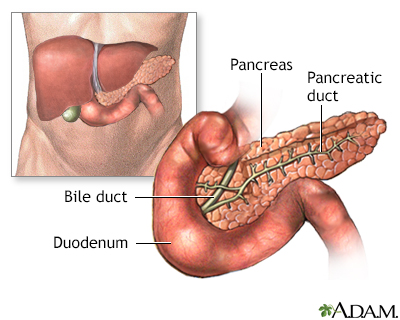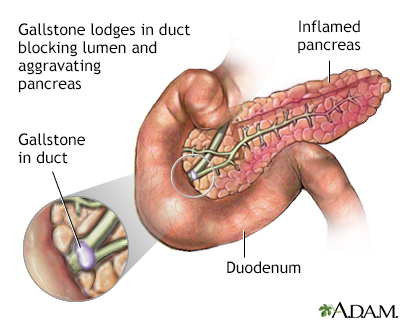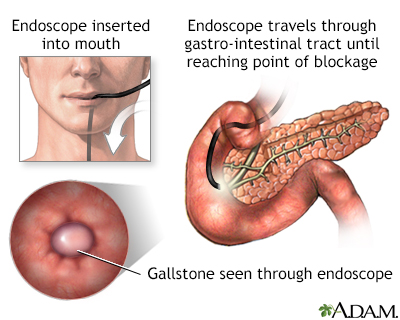Acute pancreatitis
Gallstone pancreatitis; Pancreas - inflammationAcute pancreatitis is sudden swelling and inflammation of the pancreas.
Causes
The pancreas is an organ located behind the stomach. It produces the hormones insulin and glucagon. It also produces chemicals called enzymes needed to digest food.
Most of the time, the enzymes are active only after they reach the small intestine.
- If these enzymes become active inside the pancreas, they can digest the tissue of the pancreas. This causes swelling, bleeding, and damage to the organ and its blood vessels.
- This problem is called acute pancreatitis.
Acute pancreatitis affects men more often than women. Certain diseases, surgeries, and habits make you more likely to develop this condition.
- Alcohol use is responsible for up to 70% of cases in the United States. About 5 to 8 drinks per day for 5 or more years can damage the pancreas.
- Gallstones are the next most common cause. When the gallstones travel out of the gallbladder into the bile ducts, they may block the opening that drains bile and enzymes. The bile and enzymes "back up" into the pancreas and cause swelling.
- Genetics may be a factor in some cases. Sometimes, the cause is not known.
Other conditions that have been linked to pancreatitis are:
- Autoimmune problems (when the immune system attacks the body)
- Damage to the bile ducts or pancreas during surgery
- High blood levels of a fat called triglycerides -- most often above 1,000 mg/dL
Triglycerides
Familial hypertriglyceridemia is a common disorder passed down through families. It causes a higher-than-normal level of triglycerides (a type of fa...
 ImageRead Article Now Book Mark Article
ImageRead Article Now Book Mark Article - Injury to the pancreas from an accident
Other causes include:
- After certain procedures used to diagnose gallbladder and pancreas problems (endoscopic retrograde cholangiopancreatography, ERCP) or ultrasound guided biopsy
Endoscopic retrograde cholangiopancreat...
ERCP is short for endoscopic retrograde cholangiopancreatography. It is a procedure that looks at the bile and pancreatic ducts. It is done through...
 ImageRead Article Now Book Mark Article
ImageRead Article Now Book Mark Article - Cystic fibrosis
Cystic fibrosis
Cystic fibrosis is a disease that causes thick, sticky mucus to build up in the lungs, digestive tract, and other areas of the body. It is one of th...
 ImageRead Article Now Book Mark Article
ImageRead Article Now Book Mark Article - Overactive parathyroid gland
Overactive parathyroid gland
Hyperparathyroidism is a condition in which 1 or more of the parathyroid glands in your neck produce too much parathyroid hormone (PTH).
 ImageRead Article Now Book Mark Article
ImageRead Article Now Book Mark Article - Reye syndrome
Reye syndrome
Reye syndrome is characterized by sudden (acute) brain damage and liver function problems. This condition does not have a known cause. This syndrome...
 ImageRead Article Now Book Mark Article
ImageRead Article Now Book Mark Article - Use of certain medicines (especially estrogens, corticosteroids, sulfonamides, thiazides, and azathioprine)
- Certain infections, such as mumps, that involve the pancreas
Symptoms
The main symptom of pancreatitis is pain felt in the upper left side or middle of the abdomen. The pain:
Pain
Abdominal pain is pain that you feel anywhere between your chest and groin. This is often referred to as the stomach region or belly.

- May be worse within minutes after eating or drinking at first, more commonly if foods have a high fat content
- Becomes constant and more severe, lasting for several days
- May be worse when lying flat on the back
- May spread (radiate) to the back or below the left shoulder blade
People with acute pancreatitis often look ill and have a fever, nausea, vomiting, and sweating.
Other symptoms that may occur with this disease include:
- Clay-colored stools
- Bloating and fullness
Bloating and fullness
Gas is air in the intestine that is passed through the rectum. Air that moves from the digestive tract through the mouth is called belching. Gas is ...
 ImageRead Article Now Book Mark Article
ImageRead Article Now Book Mark Article - Hiccups
Hiccups
A hiccup is an unintentional movement (spasm) of the diaphragm, the muscle at the base of the lungs. The spasm is followed by quick closing of the v...
Read Article Now Book Mark Article - Indigestion
Indigestion
Indigestion (dyspepsia) is a mild discomfort in the upper belly or abdomen. It often occurs during or right after eating. It may feel like:Heat, bu...
 ImageRead Article Now Book Mark Article
ImageRead Article Now Book Mark Article - Mild yellowing of the skin and whites of the eyes (jaundice)
- Swollen abdomen
Swollen abdomen
A swollen abdomen is when your belly area is bigger than usual.
 ImageRead Article Now Book Mark Article
ImageRead Article Now Book Mark Article
Exams and Tests
The health care provider will do a physical exam, which may show:
- Abdominal tenderness or lump (mass)
- Fever
- Low blood pressure
Low blood pressure
Low blood pressure occurs when blood pressure is below normal. This means the heart, brain, and other parts of the body may not get enough blood. I...
 ImageRead Article Now Book Mark Article
ImageRead Article Now Book Mark Article - Rapid heart rate
- Rapid breathing (respiratory) rate
Lab tests that show the release of pancreatic enzymes will be done. These include:
- Increased serum amylase level
Serum amylase level
Amylase is an enzyme that helps digest carbohydrates. It is made primarily in the pancreas and the glands that make saliva, and can be found at low ...
 ImageRead Article Now Book Mark Article
ImageRead Article Now Book Mark Article - Increased serum lipase level (a more specific indicator of pancreatitis than amylase levels)
Serum lipase level
Lipase is a protein (enzyme) released by the pancreas into the small intestine. It helps the body absorb fat. This test is used to measure the amou...
 ImageRead Article Now Book Mark Article
ImageRead Article Now Book Mark Article - Increased urine amylase level
Urine amylase level
This is a test that measures the amount of amylase in urine. Amylase is an enzyme that helps digest carbohydrates. It is produced mainly in the pan...
 ImageRead Article Now Book Mark Article
ImageRead Article Now Book Mark Article
Other blood tests that can help diagnose pancreatitis or its complications include:
- Complete blood count (CBC)
Complete blood count
A complete blood count (CBC) test measures the following:The number of white blood cells (WBC count)The number of red blood cells (RBC count)The numb...
 ImageRead Article Now Book Mark Article
ImageRead Article Now Book Mark Article - Comprehensive metabolic panel
Comprehensive metabolic panel
A comprehensive metabolic panel is a group of blood tests. They provide an overall picture of your body's chemical balance and metabolism. Metaboli...
 ImageRead Article Now Book Mark Article
ImageRead Article Now Book Mark Article
The following imaging tests that can show swelling of the pancreas may be done, but are not always needed to make a diagnosis of acute pancreatitis:
- CT scan of the abdomen
CT scan of the abdomen
An abdominal CT scan is an imaging test that uses x-rays to create cross-sectional pictures of the belly area. CT stands for computed tomography....
 ImageRead Article Now Book Mark Article
ImageRead Article Now Book Mark Article - MRI of the abdomen
MRI of the abdomen
An abdominal magnetic resonance imaging scan is an imaging test that uses powerful magnets and radio waves. The waves create pictures of the inside ...
 ImageRead Article Now Book Mark Article
ImageRead Article Now Book Mark Article - Ultrasound of the abdomen
Ultrasound of the abdomen
Abdominal ultrasound is a type of imaging test. It is used to look at organs in the abdomen, including the liver, gallbladder, pancreas, and kidneys...
 ImageRead Article Now Book Mark Article
ImageRead Article Now Book Mark Article
Treatment
Treatment often requires a stay in the hospital. It may involve:
- Pain medicines
- Fluids given through a vein (IV)
- Stopping food or fluid by mouth to limit the activity of the pancreas. In the past, patients did not get food for many days. However, feeding the digestive tract is an important treatment for pancreatitis, therefore a feeding tube may be put into the stomach or intestine until you can eat by mouth again.
A tube may be inserted through the nose or mouth to remove the contents of the stomach. This may be done if vomiting and severe pain do not improve. The tube will stay in for 1 to 2 days to 1 to 2 weeks.
Treating the condition that caused the problem can prevent repeated attacks.
In some cases, therapy is needed to:
- Drain fluid that has collected in or around the pancreas
Fluid that has collected in or around t...
A pancreatic pseudocyst is a fluid-filled sac in the abdomen that arises from the pancreas. It may also contain tissue from the pancreas, enzymes, a...
 ImageRead Article Now Book Mark Article
ImageRead Article Now Book Mark Article - Remove gallstones
Gallstones
Gallstones are hard deposits that form inside the gallbladder. These may be as small as a grain of sand or as large as a golf ball.
 ImageRead Article Now Book Mark Article
ImageRead Article Now Book Mark Article - Relieve blockages of the pancreatic duct
In the most severe cases, surgery is needed to remove damaged, dead or infected pancreatic tissue.
Avoid smoking, alcoholic drinks, and fatty foods after the attack has improved.
Outlook (Prognosis)
Most cases go away in a week or less. However, some cases develop into a life-threatening illness.
The death rate is high when:
- Bleeding in the pancreas has occurred.
Bleeding in the pancreas
Hemorrhage is the medical term for bleeding. It most often refers to excessive bleeding. Hemorrhagic diseases are caused by bleeding, or they resul...
 ImageRead Article Now Book Mark Article
ImageRead Article Now Book Mark Article - Liver, heart, or kidney problems are also present.
- An abscess forms the pancreas.
- There is death or necrosis of larger amounts of tissue in the pancreas.
Sometimes the swelling and infection do not fully heal. Repeat episodes of pancreatitis may also occur. Either of these can lead to long-term damage of the pancreas (called chronic pancreatitis).
Long-term damage of the pancreas
Pancreatitis is swelling of the pancreas. Chronic pancreatitis is present when this problem does not heal or recurs and does not improve, gets worse...

Possible Complications
Pancreatitis can return. The chances of it returning depend on the cause, and how well it can be treated. Complications of acute pancreatitis may include:
- Acute kidney failure
Acute kidney failure
Acute kidney failure is the rapid (less than 2 days) loss of your kidneys' ability to remove waste and help balance fluids and electrolytes in your b...
 ImageRead Article Now Book Mark Article
ImageRead Article Now Book Mark Article - Long-term lung damage (due to adult respiratory distress syndrome or ARDS)
Long-term lung damage
Acute respiratory distress syndrome (ARDS) is a life-threatening lung condition that prevents enough oxygen from getting to the lungs and into the bl...
 ImageRead Article Now Book Mark Article
ImageRead Article Now Book Mark Article - Buildup of fluid in the abdomen (ascites)
Ascites
Ascites is the build-up of fluid in the space between the lining of the abdomen and abdominal organs.
 ImageRead Article Now Book Mark Article
ImageRead Article Now Book Mark Article - Fluid collections in the pancreas (pancreatic pseudocysts) that may become infected (pancreatic abscess)
- Heart failure
Heart failure
Heart failure is a condition in which the heart is no longer able to pump oxygen-rich blood to the rest of the body efficiently. This causes symptom...
 ImageRead Article Now Book Mark Article
ImageRead Article Now Book Mark Article
When to Contact a Medical Professional
Contact your provider if:
- You have intense, constant abdominal pain.
- You develop other symptoms of acute pancreatitis.
Prevention
You may lower your risk of new or repeat episodes of pancreatitis by taking steps to prevent the medical conditions that can lead to the disease:
- DO NOT drink alcohol if it is the likely cause of the acute attack.
- DO NOT smoke. Tobacco smoking can worsen acute and chronic pancreatitis.
- Make sure children receive vaccines to protect them against mumps and other childhood illnesses.
Children receive vaccines
Vaccines are used to boost your immune system, reduce the risk of infection, and lessen the severity of infections, including those that cause seriou...
 ImageRead Article Now Book Mark Article
ImageRead Article Now Book Mark Article - Treat medical problems that lead to high blood levels of triglycerides.
References
Crockett SD, Wani S, Gardner TB, Falck-Ytter Y, Barkun AN. American Gastroenterological Association Institute Clinical Guidelines Committee. American Gastroenterological Association Institute Guideline on initial management of acute pancreatitis. Gastroenterology. 2018;154(4):1096-1101. PMID: 29409760 pubmed.ncbi.nlm.nih.gov/29409760/.
Forsmark CE. Pancreatitis. In: Goldman L, Cooney KA, eds. Goldman-Cecil Medicine. 27th ed. Philadelphia, PA: Elsevier; 2024:chap 130.
Tenner S, Vege SS, Sheth SG, et al. American College of Gastroenterology Guidelines: management of acute pancreatitis. Am J Gastroenterol. 2024 1;119(3):419-437. Epub 2023 Nov 7. PMID: 38857482. pubmed.ncbi.nlm.nih.gov/38857482/.
Van Buren G, Fisher WE. Acute and chronic pancreatitis. In: Kellerman RD, Rakel DP, Heidelbaugh JJ, Lee EM, eds. Conn's Current Therapy 2024. Philadelphia, PA: Elsevier; 2024:175-182.
Vege SS. Acute pancreatitis. In: Feldman M, Friedman LS, Brandt LJ, eds. Sleisenger and Fordtran's Gastrointestinal and Liver Disease: Pathophysiology/Diagnosis/Management. 11th ed. Philadelphia, PA: Elsevier; 2021:chap 58.
Digestive system - illustration
The esophagus, stomach, large and small intestine, aided by the liver, gallbladder and pancreas convert the nutritive components of food into energy and break down the non-nutritive components into waste to be excreted.
Digestive system
illustration
Endocrine glands - illustration
Endocrine glands release hormones (chemical messengers) into the bloodstream to be transported to various organs and tissues throughout the body. For instance, the pancreas secretes insulin, which allows the body to regulate levels of sugar in the blood. The thyroid gets instructions from the pituitary to secrete hormones which determine the rate of metabolism in the body (the more hormone in the bloodstream, the faster the chemical activity; the less hormone, the slower the activity).
Endocrine glands
illustration
Pancreatitis, acute - CT scan - illustration
This upper abdominal CT scan shows inflammation and swelling of the pancreas caused by acute infection (pancreatitis).
Pancreatitis, acute - CT scan
illustration
Pancreatitis - series
Presentation
Digestive system - illustration
The esophagus, stomach, large and small intestine, aided by the liver, gallbladder and pancreas convert the nutritive components of food into energy and break down the non-nutritive components into waste to be excreted.
Digestive system
illustration
Endocrine glands - illustration
Endocrine glands release hormones (chemical messengers) into the bloodstream to be transported to various organs and tissues throughout the body. For instance, the pancreas secretes insulin, which allows the body to regulate levels of sugar in the blood. The thyroid gets instructions from the pituitary to secrete hormones which determine the rate of metabolism in the body (the more hormone in the bloodstream, the faster the chemical activity; the less hormone, the slower the activity).
Endocrine glands
illustration
Pancreatitis, acute - CT scan - illustration
This upper abdominal CT scan shows inflammation and swelling of the pancreas caused by acute infection (pancreatitis).
Pancreatitis, acute - CT scan
illustration
Pancreatitis - series
Presentation
Review Date: 12/31/2023
Reviewed By: Jenifer K. Lehrer, MD, Department of Gastroenterology, Aria - Jefferson Health Torresdale, Jefferson Digestive Diseases Network, Philadelphia, PA. Review provided by VeriMed Healthcare Network. Also reviewed by David C. Dugdale, MD, Medical Director, Brenda Conaway, Editorial Director, and the A.D.A.M. Editorial team.








